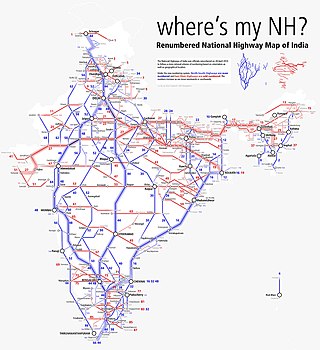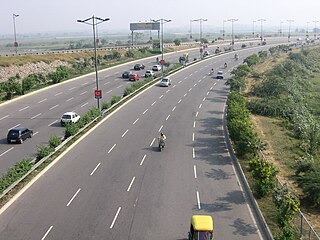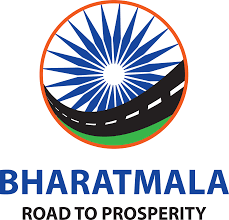
Transport in India consists of transport by land, water and air. Road transport is the primary mode of transport for most Indian citizens, and India's road transport systems are among the most heavily used in the world.

The Golden Quadrilateral is a national highway network connecting several major industrial, agricultural and cultural centres of India. It forms a quadrilateral with all the four major metro cities of India forming the vertices, viz., Delhi (north), Kolkata (east), Mumbai (west) and Chennai (south). Other major cities connected by this network include Ahmedabad, Bengaluru, Balasore, Bhadrak, Bhubaneswar, Cuttack, Berhampur, Durgapur, Guntur, Jaipur, Kanpur, Pune, Kolhapur, Surat, Vijayawada, Eluru, Ajmer, Vizag, Bodhgaya, Varanasi, Prayagraj, Agra, Mathura, Dhanbad, Gandhinagar, Udaipur, and Vadodara. The main objective of these super highways is to reduce the travel time between the major cities of India, running roughly along the perimeter of the country. The North–South corridor linking Srinagar and Kanyakumari, and East–West corridor linking Silchar (Assam) and Porbandar (Gujarat) are additional projects. These highway projects are implemented by the National Highway Authority Of India (NHAI). At 5,846 kilometres (3,633 mi), it is the largest highway project in India and the fifth longest in the world. It is the first phase of the National Highways Development Project (NHDP), and consists of two, four, and six-lane express highways, built at a cost of ₹600 billion (US$7.5 billion). The project was planned in 1999, launched in 2001, and was completed in July 2013.

The National highways in India are a network of trunk roads owned by the Ministry of Road Transport and Highways. National highways have flyover access or some controlled-access, where entrance and exit is through the side of the flyover, at each intersection of highways flyovers are provided to bypass the city/town/village traffic and these highways are designed for speed of 100 km/hr. Some national highways have interchanges in between, but do not have total controlled-access throughout the highways. It is constructed and managed by the Central Public Works Department (CPWD), the National Highways and Infrastructure Development Corporation Limited (NHIDCL), and the public works departments (PWD) of state governments. Currently, the longest National Highway in India is National Highway 44 at 4,112 km.

Reliance Infrastructure Limited (R-Infra), formerly Reliance Energy Limited (REL) and Bombay Suburban Electric Supply (BSES), is an Indian private sector enterprise involved in power generation, infrastructure, construction and defence. It is part of the Reliance Anil Dhirubhai Ambani Group. The company is headed by its chairman, Anil Ambani, and chief executive officer, Punit Narendra Garg. The corporate headquarters is in Navi Mumbai. Reliance Infrastructure's interests are in the fields of power plants, metro rail, airports, bridges, toll roads, and defence. It is a major shareholder in the other group company, Reliance Power and Reliance Naval and Engineering Limited.

Roads are an important mode of transport in India. India has a network of over 6,215,797 kilometres (3,862,317 mi) of roads as of 1 December 2021. This is the second-largest road network in the world, after the United States with 6,853,024 kilometres (4,258,272 mi). At of roads per square kilometre of land, the quantitative density of India's road network is equal to that of Hong Kong, and substantially higher than the United States, China, Brazil and Russia. Adjusted for its large population, India has approximately 5.13 kilometres (3.19 mi) of roads per 1,000 people, which is much lower than United States 20.5 kilometres (12.7 mi) but higher than that of China 3.6 kilometres (2.2 mi). India's road network carries over 71 percent of its freight and about 85 percent of passenger traffic.

The National Highways Development Project (NHDP) was a project of four laning of existing national highways and six laning of selected major national highways of India. The project was started in 1998 under the leadership of Prime Minister, Atal Bihari Vajpayee. National Highways account for only about 2% of the total length of roads, but carry about 40% of the total traffic across the length and breadth of the country. This project is managed by the National Highways Authority of India (NHAI) under the Ministry of Road, Transport and Highways. The NHDP represents 49,260 km of roads and highways work and construction in order to boost economic development of the country. The government has planned to end the NHDP program in early 2018 and subsume the ongoing projects under a larger Bharatmala project.
The Ministry of Development of North Eastern Region is a Government of India ministry, established in September 2001, which functions as the nodal Department of the Central Government to deal with matters related to the socio-economic development of the eight States of Northeast India: Arunachal Pradesh, Assam, Manipur, Meghalaya, Mizoram, Nagaland, Tripura and Sikkim. It acts as a facilitator between the Central Ministries/ Departments and the State Governments of the North Eastern Region in the economic development including removal of infrastructural bottlenecks, provision of basic minimum services, creating an environment for private investment and to remove impediments to lasting peace and security in the North Eastern Region.

The Delhi–Noida Direct Flyway or DND Flyway is India's first 8-lane wide, 9.2 km (5.7 mi) long access-controlled expressway in Delhi NCR. It connects Maharani Bagh and Nizamuddin on the western side to Noida (Sector-15A) and Mayur Vihar on the eastern side of the Yamuna river. The Noida Toll Bridge Company Limited (NTBCL) owned by IL&FS, operate and maintains it on build-own-operate-transfer (BOOT) basis. The expressway, which was opened to the public in January 2001 was constructed by Japan based Mitsui-Marubeni Corporation Ltd.
Delhi, a major metropolitan region of India, is connected to various parts of country through several national highways and expressways. All the highways and expressways from Delhi lead to Haryana or Uttar Pradesh and continue from there.

Old National Highway 2 or Old NH 2, was a major National Highway in India, that connected the states of Delhi, Haryana, Uttar Pradesh, Bihar, Jharkhand and West Bengal. It constitutes a major portion of the historical Grand Trunk Road along with old NH 91 and old NH 1 in India. The highway connects national capital Delhi with Kolkata as well as important cities such as Faridabad, Mathura, Agra, Kanpur, Allahabad, Varanasi, Dhanbad, Asansol, Durgapur and Bardhaman.

Yamuna Expressway is a 6-lane wide and 165.5 km long access-controlled expressway in the Indian state of Uttar Pradesh. It is presently India's 6th longest expressway. It was built to de-congest the older Delhi–Agra national highway (NH-2) or Mathura Road.

Expressways are the highest class of roads in India. As of June 2023, India has a total length of 4,219 km of expressways. These are controlled-access highways where entrance and exits are controlled by the use of cloverleaf or trumpet or grade separated interchanges that are incorporated into the design of the expressway and designed for maximum speed of 120 km/hr, whereas National highways are flyover access or controlled-access highway, where entrance and exit is through the side of the flyover, at each intersection of highway with road, flyovers are provided to bypass the city/town/village traffic and these highways are designed for speed of 100 km/hr. Some roads are not access-controlled expressways, but are still named as expressways, such as the Biju Expressway, these are actually state highways which are not declared by central government as an Expressway, hence not an Expressway or National Highway. Mumbai–Pune Expressway is the first 6-lane operational expressway in India started in 2002. Expressways follow standards set by Indian Roads Congress and Bureau of Indian Standards.
The Trans-Arunachal Highway (TAH), which includes an existing 1,811 km (1,125 mi) route comprising NH-13 and parts of NH-15, NH-215 and SH-25, is an under-construction 2-lane more than 2,407 km (1,496 mi) long highway passing through 16 districts in Arunachal Pradesh state in India. It runs from LAC in Tawang in northwest to Kanubari in southeast at tri-junction of Assam-Nagaland-Arunachal Pradesh. It connects at least 16 districts of Arunachal Pradesh.
IRB Infrastructure Developers Limited, is an Indian highway construction company headed by Mr. Virendra Dattatraya Mhaiskar. It was incorporated in 1998, with its headquarters in Mumbai, Maharashtra, India. It is part of the IRB Group and was ranked 200th in the Fortune India 500 list in 2020. IRB Infrastructure, which executed the country's first build-operate-transfer (BOT) road project, is one of the largest operators of such ventures. Currently it has about 3,404 lane Km operational and about 2,330 lane Km under development. Among its notable projects are the Mumbai-Pune Expressway and the Ahmedabad-Vadodara Expressway. In 2012, IRB acquired Tamil Nadu based BOT road builder MVR Infrastructure and Tollways for ₹130 crore. The company got the contract of Ganga Expressway, the longest under-construction expressway in Uttar Pradesh.

The Kaladan Road Project is a US$484 million project connecting the eastern Indian seaport of Kolkata with Sittwe seaport in Rakhine State, Myanmar by sea. In Myanmar, it will then link Sittwe seaport to Paletwa in Chin State via the Kaladan river boat route, and then from Paletwa by road to Mizoram state in Northeast India. All components of the project, including Sittwe port and power, river dredging, Paletwa jetty, have been completed, except the under construction Zorinpui-Paletwa road. Originally, the project was scheduled to be completed by 2014, but end-to-end project is expected to be fully operational only by March 2023 as per March 2021 update.

The Agra–Lucknow Expressway is a 302 km long, 6-lane wide access-controlled expressway constructed by the Uttar Pradesh Expressways Industrial Development Authority (UPEIDA) to reduce traffic in already congested roads and to reduce pollution and carbon footprint. The expressway reduced the distance between the cities of Agra and Lucknow in the Indian state of Uttar Pradesh and is presently one of the India's longest operational expressway.
Bajrang Kumar Choudhary serves as the Managing Director of Bharat Road Network Limited. He has been the Chief Executive Officer of Infrastructure Project Development for Srei Infrastructure Finance Limited and served as its Senior Vice President in Managing Director's Secretariat. He is also on the Board of several other companies such as Kolkata Mass Rapid Transit Private Limited, Bharat Road Network Limited, AMRL Hitech City Limited, Hyderabad Information Technology Venture Enterprises Limited, I Log Ports Private Limited among others.

The Bharatmala Pariyojna is an ecosystem of road development which includes development of tunnels, bridges, elevated corridors, flyovers, overpass, interchanges, bypasses, ring roads etc. to provide shortest, jam free & optimized connectivity to multiple places, it is a centrally-sponsored and funded Road and Highways project of the Government of India. Bharatmala is mainly focused on connecting remote areas and satellite cities of megacities such as Bengaluru, Pune, Hyderabad etc. The total investment for 83,677 km (51,994 mi) committed new highways is estimated at ₹10.63 lakh crore (US$130 billion), making it the single largest outlay for a government road construction scheme. The project will build highways from Maharashtra, Gujarat, Rajasthan, Punjab, Haryana and then cover the entire string of Himalayan territories - Jammu and Kashmir, Himachal Pradesh, Uttarakhand - and then portions of borders of Uttar Pradesh and Bihar alongside Terai, and move to West Bengal, Sikkim, Assam, Arunachal Pradesh, and right up to the Indo-Myanmar border in Manipur and Mizoram. Special emphasis will be given on providing connectivity to far-flung border and rural areas including the tribal and backward areas. Bharatmala Project will interconnect 550 District Headquarters through a minimum 4-lane highway by raising the number of corridors to 50 and move 80% freight traffic to National Highways by interconnecting 24 logistics parks, 66 inter-corridors (IC) of total 8,000 km (5,000 mi), 116 feeder routes (FR) of total 7,500 km (4,700 mi) and 7 north east Multi-Modal waterway ports.
Varanasi–Kolkata Expressway, also known as Varanasi–Ranchi–Kolkata Expressway, is an approved 610 km (380 mi) long, six-lane, greenfield access-controlled expressway, which will connect the holy city of Varanasi in Uttar Pradesh with the capital of West Bengal, Kolkata, through the capital of Jharkhand, Ranchi. It will run almost parallel with the Grand Trunk Road or the Asian Highway 1, and will pass through four states–Uttar Pradesh, Bihar, Jharkhand and West Bengal. The expressway is a part of Bharatmala Pariyojana, and it will reduce both travel time and distance, from 12-14 hours to only 6-7 hours, and from 690 km (430 mi) to 610 km (380 mi). It will start from Chandauli district in Uttar Pradesh, and will terminate near Uluberia, Howrah district, West Bengal.
Allied Blenders & Distillers is the third largest IMFL in India and the largest Indian-owned alcoholic beverage company, with its headquarters in Mumbai, India. They export to 22 countries around the world. It is a major distributor of whiskey, Rum, Vodka, brandy and other spirits.











